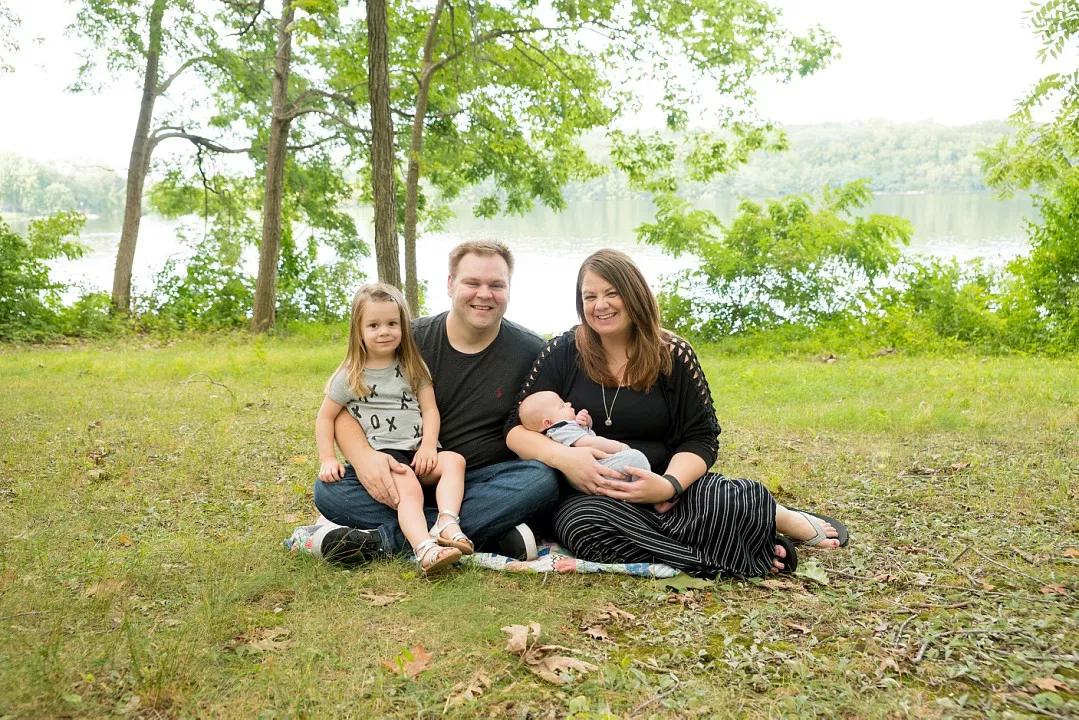Collaborative care during high-risk pregnancy

I delivered my first baby at another hospital and due to delivery difficulties; I knew if I got pregnant again, I wanted to transfer my care to University of Iowa Health Care.
I had heard many great things about Kelly Ward, MD, so when I found out I was pregnant I scheduled an appointment with her. When Dr. Ward walked into the room, I knew I made the right choice. She was so compassionate and she was the first person who understood how I felt after my first delivery.
At my 20-week ultrasound, the providers discovered I had complete placenta previa, which means my placenta was covering my cervix completely. With this diagnosis, women usually have bleeding in the third trimester and have to deliver early. I was told no heavy lifting and on pelvic rest. I was also told not to travel outside of the Iowa City area, as I needed to be near the hospital in case I started to hemorrhage.
When I went to my 24-week ultrasound, the providers discovered I had another placental problem called placenta accreta. Placenta accreta is a life-threatening condition where the placenta attaches too deep in the uterine wall. It can occur from repeated C-sections. I was scheduled for an MRI to see how deeply the placenta was attached; thankfully, the results showed it had not attached to other organs such as the bladder.
I was very frightened by this diagnosis as it has a 7 percent mortality rate caused by hemorrhaging. Even though that seems low, I only had an 11 percent chance of getting placenta accreta. Many patients require blood transfusions due to blood loss during the C-section. Most of the time, a hysterectomy is the only way to stop the hemorrhaging since the placenta does not want to pull away from the uterus.
When I thought nothing else could go wrong, I was diagnosed with gestational diabetes. I was not able to control my fasting sugars so I had to take medication to control it.
With all of my difficulties, I had many people on my care team–Dr. Ward, obstetrician/gynecologist; David P. Bender, MD, gynecologic oncologist; the high-risk pregnancy team; and anesthesiologists. They all had to collaborate and pick a date for delivery that would be safe for my baby and me. My care team chose 34 weeks and 5 days. They wanted the C-section with a hysterectomy in a controlled environment versus an emergent situation. I also needed to deliver in the main operating room so they would be close to the blood bank.
I was lucky to not have any bleeding during my pregnancy as some patients with this diagnosis have bleeding in the third trimester and have to be placed on hospital bed rest until delivery. My care team decided I needed to have steroid shots for the baby and that I needed to be admitted two days prior to delivery since it may cause a spike in sugars and I needed to be monitored.
The day before my surgery I met my anesthesia resident, Dr. Bob Hitchcock, who was an amazing doctor. He took time to answer all my questions. He explained the need to use general anesthesia during the entire C-section as a precaution in case I hemorrhaged. This would allow them to begin to control bleeding immediately rather than having to wait until general anesthesia was administered.
The day of delivery I was extremely nervous. The physicians would not know how bad my placenta accreta was until they were performing the C-section. Both Drs. Ward and Bender stopped by my room before we started. Dr. Bender prepared me by saying there would be a lot people in the room and it will be loud. However, everyone was in the room for a reason to help with the delivery and the baby.
As I lay on the operating room table, I remember feeling extremely nervous with thoughts of survival running through my head. Dr. Ward was by my side holding my hand while I was being prepped. I felt so safe even though I was in a dangerous situation. There were six units of blood on hand, the cell saver, and the blood bank were on standby.
I woke up from anesthesia with Dr. Ward stating they were able to save my uterus and I had lost minimal blood for the situation–only about twice as much as a normal C-section. Over the next two days I did have to have two blood transfusions, as my blood count was low.
My son, Leo, stayed in the NICU for 19 days due to minor issues, but is doing great now. He has more than doubled his weight and is very much loved by his big sister, Harper. We are all doing great and I thank my care team for our successful outcome. It was one of the scariest times of my life but they all worked together and made sure my baby and I were safe. Now our family is complete thanks to Dr. Ward, Dr. Bender, and the care team.
Angie Poulsen, patient
University of Iowa Health Care